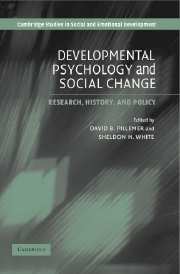Book contents
- Frontmatter
- Contents
- Preface
- List of Contributors
- Introduction: What Kind of Science Is Developmental Psychology?
- Part One The Developing Child: Global and Historical Perspectives
- Part Two Designing Child and Family Policies
- 4 The Effects of Welfare Reform and Poverty Policies on Children and Families
- 5 The Disconnect between Research and Policy on Child Care
- 6 Child Development and Child-Care Policy: Modest Impacts
- Part Three Designing Child Health Policies
- Part Four Designing Effective Learning Environments for Children and Adolescents
- Index
- References
4 - The Effects of Welfare Reform and Poverty Policies on Children and Families
Published online by Cambridge University Press: 03 December 2009
- Frontmatter
- Contents
- Preface
- List of Contributors
- Introduction: What Kind of Science Is Developmental Psychology?
- Part One The Developing Child: Global and Historical Perspectives
- Part Two Designing Child and Family Policies
- 4 The Effects of Welfare Reform and Poverty Policies on Children and Families
- 5 The Disconnect between Research and Policy on Child Care
- 6 Child Development and Child-Care Policy: Modest Impacts
- Part Three Designing Child Health Policies
- Part Four Designing Effective Learning Environments for Children and Adolescents
- Index
- References
Summary
Over the past 50 years, U.S. policies for low-income families with children have evolved and changed dramatically. Although poverty rates among families with children were higher in the 1950s than they have been since, policymakers gave relatively little attention to problems associated with child poverty until the War on Poverty began in the 1960s. Developmental psychologists participated in the war on poverty largely by creating, testing, and evaluating intervention programs for children, including Head Start, Follow Through, and many others. Economic interventions, subsumed in the label “welfare policy,” that included cash assistance, medical care, and employment services for low-income families were, however, primarily the province of labor economists. Scholars and policy researchers designed, administered, and evaluated various policies, using sophisticated methods and theoretical models, from the 1960s onward, but there was little communication between economists and developmental psychologists.
In the late 1980s and the 1990s, these two research communities began to converge. Specialists in child development joined interdisciplinary teams to study the impacts of welfare and employment policies on children and families. Psychologists and sociologists spawned a series of empirical investigations, based in sophisticated theory, of the effects of poverty, family income, and income loss on the development of children and adolescents (e.g., Conger & Elder, 1994; Elder & Caspi, 1987; McLoyd, 1990, 1997, 1998). The result is a body of research, drawing on different methods and theoretical traditions, that not only informs policy, but also makes a contribution to developmental science.
- Type
- Chapter
- Information
- Developmental Psychology and Social ChangeResearch, History and Policy, pp. 83 - 103Publisher: Cambridge University PressPrint publication year: 2005



